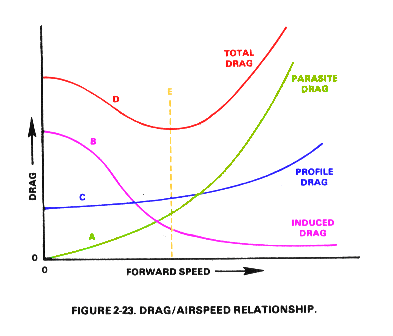[Top]
[Up]
[Prev]
[Next]
Drag
Drag is the force that opposes the motion of an aircraft through the air.
Total drag produced by an aircraft is the sum of the profile
drag, induced drag, and parasitedrag. Total drag is
primarily a function of airspeed. The airspeed that produces the lowest
total drag normally determines the aircraft best-rate-of-climb speed,
minimum rate-of-descent speed for autorotation, and maximum endurance
speed.
The following picture illustrates the different forms of drag versus airspeed:

- Profile drag is the drag incurred from frictional
resistance of the blades passing through the air. It does not
change significantly with angle of attack of the airfoil
section, but increases moderately as airspeed increases.
- Induced drag is the drag incurred as a result of
production of lift. Higher angles of attack which produce
more lift also produce increased induced drag. In rotary-wing
aircraft, induced drag decreases with increased aircraft
airspeed. The induced drag is the portion of the total
aerodynamic force which is oriented in the direction
opposing the movement of the airfoil. Think of it as lift
which is in the wrong direction.
- Parasite drag is the drag incurred from the nonlifting
portions of the aircraft. It includes the form drag and skin
friction associated with the fuselage, cockpit, engine
cowlings, rotor hub, landing gear, and tail boom to mention
a few. Parasite drag increases with airspeed.
Curve "A" shows that parasite drag is very low at slow airspeeds and
increases with higher airspeeds. Parasite drag goes up at an increasing
rate at airspeeds above the midrange.
Curve "B" shows how induced drag decreases as aircraft airspeed increases.
At a hover, or at lower airspeeds, induced drag is highest. It decreases
as airspeed increases and the helicopter moves into undisturbed air.
Curve "C" shows the profile drag curve. Profile drag remains relatively
constant throughout the speed range with some increase at the higher
airspeeds.
Curve "D" shows total drag and represents the sum of the other three
curves. It identifies the airspeed range, line "E", at which total drag is
lowest. That airspeed is the best airspeed for maximum endurance, best
rate of climb, and minimum rate of descent in autorotation.
Paul Cantrell
paul at copters.com
(replace " at " with "@" to email me - this avoids SPAMMERS I hope)
[Top]
[Up]
[Prev]
[Next]

